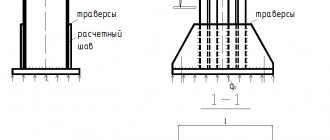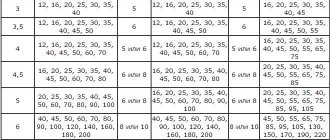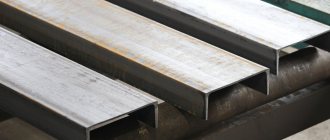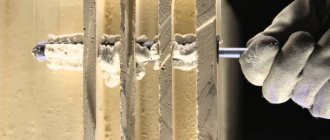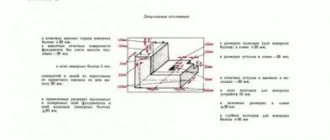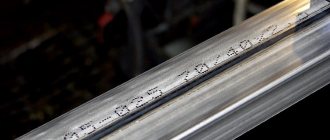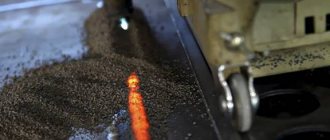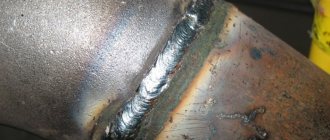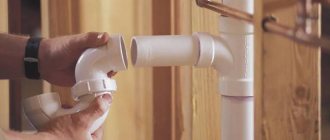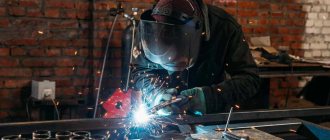Preparing and assembling parts for welding involves cleaning, aligning, marking, cutting and assembling workpieces.[context]
The edges and adjacent area, 20-30 mm on each side, are cleaned of rust, paint, scale, oil and other contaminants. High-quality prepared edges and the adjacent area have a metallic shine, which is achieved by using metal brushes, flame, and for critical connections, pickling, degreasing, and sandblasting are used.
For more information on cleaning workpieces before welding, see this article.
Parts with dents, bulges, waviness, or curvature must be straightened. When cold, sheets and rolled products can be straightened manually or using machines. If the metal is severely deformed, straightening is done in a hot state. For straightening, hammers, presses, and straightening machines are used.
The next stage of preparing parts is transferring dimensions from the drawing to the metal and marking it. For measurements and markings, meters, rulers, squares, compasses, scribers, markers, chalk and specially made templates are used. During welding, the workpieces are shortened, which must be taken into account when marking the workpieces. To do this, use an allowance of 1 mm for each transverse joint and 0.1-0.2 mm per 1 m of longitudinal seam.
After marking, the parts are cut using thermal or mechanical methods to give the workpieces the required size and shape. The edges at the sites of future welded joints are made with a file, chisel or mechanically on milling machines, planers, etc. The bevel angle depends on the welding method, the chemical composition of the metal and its thickness. Checking the bevel angle of the edges is done using templates.
Assembly of parts for welding is carried out using one of three approaches:
pre-assemble the entire part and weld all the necessary seams; weld part of the structure and gradually attach the missing parts to it; preliminary assembly and welding of the product from individual structural units;
The productivity and quality of manufacturing welded structures largely depends on the base surfaces (bases) for assembling welded structures. The surfaces with the largest dimensions are considered basic; as a guide base - the longest surface; a support base is considered to be a surface of any size in normal condition and unchanged shape (without cuts, drops, seams).
It is worth choosing a base based on the availability of assembly devices, the type of workpieces, the rigidity of the parts and the accuracy of placement, the gap between the edges. It is important to consider welding stresses and deformations.
Assembly and welding accessories
For more productive and high-quality production of welded structures, special devices for assembly and welding are used:
- universal clamp for mounting and assembling cylindrical parts;
- manual clamp for assembling profile and sheet metal;
- manual spring clamp for assembling profile metal;
- rotary screw clamp for assembly and fastening of parts in mass production;
- clamp for assembling parts of different profiles;
- corner clamp made of bolts for assembling large structures from sheet metal;
- tack bracket with a crowbar for structures that are assembled overlapping in installation conditions;
- comb on tacks for large sheet structures;
- tack washers with strips and wedges for sheet structures;
- screw tie for attracting parts;
- compression ring for large diameter pipelines;
- flexible clamp with eccentric clamp for cylindrical parts;
- screw expansion and tension mechanism for sheet structures and flat products;
- a hook with a crowbar for tightening the edges;
- screw spacer for cylindrical parts;
- spacer for assembling parts of mechanical engineering structures;
- screw stop bracket for parts of limited dimensions;
- one-sided screw stop for assembling truss profiles and other structures;
- one-sided stop for assembling structures at stationary posts.
Bending
Preparatory and welding work includes, if necessary, bending of metals. If the parts are in the form of sheets or strips, then sheet bending machines are used. Parts with a profile are bent using special presses.
If it is necessary to bend a small diameter, as well as with a large thickness, then preheating is recommended. This will make the metal more pliable and less effort will be required.
Performing tacks after assembling the structure
[context] The assembled parts are grabbed. The length of the tacks and the distance between them depends on the thickness of the metal and the length of the seam. Use tacks to fix the parts and maintain the gap between them during the welding process. The tack must weld the root of the seam, because during the welding process the tack itself may not completely melt. Dependence of the length of the tacks and the distance between them on the thickness of the metal and the length of the seam.
| Metal thickness, mm | ≤ 5 | ≤ 5 |
| Metal length, mm | ≤ 150-200 | ≤ 200 |
| Tack length, mm | ≤ 5 | 20-30 |
| Distance between tacks, mm | 50-100 | 300-500 |
It is necessary to make the potholders as low as possible, it is better if they are concave. Tack welding is done in modes similar to welding modes. Sometimes the tack is replaced with a single cut seam.
When welding copper, it is necessary to do without tacks and clamp the parts in jigs or other devices, because they cause cracks when reheated.
Tack welding heats up the metal and when the parts are subsequently moved, cracks may occur. The greater the thickness of the parts, the greater the tensile shrinkage in the tacks and the possibility of cracks. Therefore, it is advisable to use tacks for parts of small thickness (up to 6-8 mm). With greater thickness of sheets, safe movement of units can be achieved using combs (elastic tacks) or the product is assembled from flexible parts (grids, trusses, etc.)
cutting
This is one of the most important stages in preparing metal for welding. A metal element cut downwards can be immediately classified as defective. It's good if there is an opportunity to use it for other purposes. It is not very successful if an adjustment of a few millimeters is required, since such a process is quite difficult to carry out.
Cutting Tools:
- metal scissors;
- guillotine;
- Bulgarian.
For thick parts, welding can be used. To do this, you need to melt the part, and then remove the metal so that you get not a seam, but a through hole. If you follow the intended line, you will get a cut, although not too neat. Thermal cutting is applicable for parts of various configurations. Arc welding and oxygen torch are widely used.
Cutting machines are used in industrial production.
Requirements for welding metal structures
The following requirements for the installation of metal structures and welding apply to a greater extent to professional workers, but if a person wants to develop in this business, then it would be a good idea to familiarize yourself with the following information.
For certain types of metal structures, special types of materials are used from which elements of the correct geometric shape are made. It is also important that the strength and weldability characteristics comply with those required by SNIP II 23-81 and GOST 27772-88. This document also contains sections devoted to diagrams of how seams are created correctly and how their quality affects the stability and durability of the entire structure. The complexity of the work depends on the number and shape of the parts.
Download GOST 27772-88
Also an important point is the qualifications of the employee. Since there are types of welding of metal structures that can only be assembled by workers who have long been familiar with this craft, the work of beginners is simply not acceptable. A more detailed list of such structures is regulated by document RD 15.132-96 of the Ministry of Fuel and Energy of the Russian Federation.
Example of welding metal structures
Also, according to GOSTs of the Russian Federation, welding of critical metal structures must be controlled.
Download GOST 5264-80
Welding structures - features
The very concept of welding applies not only to products made of metal alloys, but also to products made of polymers, that is, for example, plastic. After all, this concept implies a thermal processing process in which two or more parts are combined into a single component.
The work itself is divided into two steps - assembly and connection. The first one has the greatest labor intensity.
After all, in order for the quality of the erected metal structure to be durable, it is necessary that all the stated requirements for the workpieces and the material from which they were made were observed until the end of the work.
Welding work
From an objective point of view, more than half of the entire work period is spent on the assembly of the future metal structure.
Welding the backing ring
The root seam is welded with electrodes with a diameter of 2.5-3.0 mm. Dimensions of the backing ring: width 20-25 mm, thickness 3-4 mm.
Before tacking and starting welding, the quality of assembly must be checked by the welder. The quality of assembly of pipeline joints under pressure above 2.2 MPa or with a diameter of more than 600 mm, regardless of the operating pressure, is checked by a master or inspector. When monitoring the quality of assembly of joints of steam pipelines with an operating temperature of 450°C and above, it is necessary to ensure the availability of the serial number of the heat and pipe number.
Design of joints of pipe elements according to RD 153-34.1-003-01
| Prepared edges of parts to be welded | Welding method | Outer diameter, mm | Structural dimensions | |||
| S, mm | a, mm | b, mm | α, deg | |||
| Cutting without bevel and without backing ring | RD | ≤ 159 | 2 — 3 | 0,5 — 1,5 | — | — |
| GLAD | ≤ 100 | 1 — 3 | ≤ 0,3; (0,5 — 1,5) | — | — | |
| G | ≤ 100 | 1 — 3 | 0,5 — 1,5 | — | — | |
| AAD | ≤ 159 | ≤ 4 | ≤ 0,3 | — | — | |
| AF | ≥ 200 | 4 — 8 | 1,5 — 2,0 | — | — | |
| V-groove without backing ring | RD, MP | any | 3 — 5 | 1,0 — 1,5 | 0,5 — 1,5 | 30±3; (25 — 45) |
| RD, MP | any | 6 — 14 | 1,0 — 2,0 | 0,5 — 1,5 | 30±3; (25 — 45) | |
| AF | ≥ 200 | 15 — 25 | 2,0 — 2,5 | 0,5 — 1,5 | 30±3; (25 — 45) | |
| KSS | ≥ 32 | 4 — 25 | ≤ 0,5;(1 -2) | 0,5 — 1,5 | 30±3; (25 — 45) | |
| RAD, ADD | ≤ 630 | 2 — 10 | ≤ 0,5; (1 — 2) | 0,5 — 1,5 | 30±3; (25 — 45) | |
| G | ≤ 159 | 3 — 8 | 1 — 2 | 0,5 — 1,5 | 30±3; (25 — 45) | |
| V-groove with backing ring | RD | >100 | ? 16 | 7 — 9 | — | 15 ±2 |
| RD | > 100 | ? 16 | 7 — 9 | — | 7 ±1 | |
| RD | >100 | ?5 | 2,5 — 3,5 | — | 30+3; (25 — 45) | |
| MP | >100 | >5 | 8 — 9 | — | 30±3; (25 — 45) | |
| MP | ≥ 133 | 2 10 . | 8 — 9 | — | 15 ± 2 | |
| AF | >200 | 4 — 5 | 4 — 5 | — | 15 ± 2 | |
| AF | >200 | >5 | 6 — 7 | — | 15 ± 2 | |
| Double bevel cutting without backing ring | Gap a without brackets - when performing the root layer by argon arc welding without filler wire, in brackets - with filler wire Edge bevel angles α in brackets are maximum permissible | |||||
| MP | ≥ 133 | ≥ 16 | 1,5 — 2,5 | 1,5 — 2,0 | 10 ± 2 | |
| KSS | ≥133 | ≥ 10 | ≤ 0,5; (1 — 2) | 1,5 — 2,0 | 10 ± 2 | |
| Cup-shaped cutting without backing ring | KSS | ≥ 108 | ≥5 | ≤ 0,5; (1 -2) | 3 ±0,2 | 15 ± 2 |
| RD - manual arc welding RAD - manual argon arc welding AAD - automatic argon arc welding G - manual gas acetylene-oxygen MP - semi-automatic in carbon dioxide AF - automatic submerged arc welding KSS - combined: the root of the weld is performed by RAD, and the remaining layers - RD or MP | ||||||
Permissible displacements (mismatches) of the internal diameters of mating pipe elements according to RD 153-34.1-003-01
| Nature of deviation and sketch of joined elements | Wall thickness, mm | Working medium pressure, kgf/cm2 (MPa) | Diameter, mm | Permissible deviation, mm |
| S ≤ 4 | P < 22 (2.2) | Dн>200 | n1≤0.2S | |
| S>4 | P < 22 (2.2) | Dн>200 | 0.15S< n1 ≤2 | |
| Not standardized | P ≥ 22 (2.2) | Not standardized | (0.02S+0.4) ≤ n1 ≤ 1 | |
| Not standardized | Not standardized | Dp2-Dp1 ≤ 2 | n1 ≤ 1 | |
| Not standardized | Not standardized | Not standardized | For n ≤ 6, shaped backing ring of size n1≤1 |
Edge preparation steps
Cleaning the product
Welding work must be carried out on previously prepared surfaces – cleaned of mechanical contaminants and chemical films. The presence of even small particles of contaminants can lead to cracking of the structure, porosity, and stress in the metal. As a result, the welded joint loses its quality
characteristics.
Do not forget about the oxide film that forms on the surface of metals when they come into contact with air. It is heat-resistant and prevents high-quality welding. You can remove it either with a grinder or manually with a metal brush.
In production, parts are cleaned using sandblasting and shot blasting machines. Dry cleaning is also carried out - by immersing the products for a certain time in a bath with chemical reagents. This type of cleaning is mainly used when preparing non-ferrous metal parts, while ferrous and steel workpieces are cleaned by hand.
Preparation of edges for welding
The edges of workpieces, especially those of large thickness, must first be cleaned and given the desired geometric shape. There are flat, V-shaped and X-shaped edges. Flat edges are used when joining thin products, the second two types are used when joining thick workpieces.
Important: edges are not processed if the thickness of the part is no more than 3 mm.
Preparation of edges for welding consists of processing the gap width, cutting angle, and adjusting the length of the slope. When preparing edges for welding pipes of various thicknesses, their processing is especially important - otherwise the metal will not be welded through. Therefore, it is important to choose the right bevel, thanks to which the transition between parts will be smooth. And this will relieve the load stress during use of the finished product.
Machines or hand tools are used to trim edges when preparing pipes for cold welding. The thermal method involves the use of burners - manual or automatic.
Cold preparation of metal for welding is considered to be of higher quality. In this case, the assembly accuracy of the final product increases significantly. And after heat treatment, the chamfers often need to be brought to the correct size and shape, especially when preparing pipes for welding.
Positive aspects of welding
In addition to reducing working time and quality, welding has a positive effect on other characteristics:
- Due to the fact that during the welding process only two elements are involved, excluding the influence of other factors, the final soldering in mass does not differ in any way from the original version, which in turn allows saving the amount of material.
- Due to its characteristics, welding is almost completely devoid of restrictions in work due to the material thickness factor. All responsibility for this shifts only to the use of certain equipment.
- A variety of modern welding machines make it possible to carry out joining work with almost any material without loss of seam strength, even taking into account the factor of manipulating such a complex material as aluminum.
- A significant positive aspect of using welding is saving money and working time.
- The heavier the type of welding, the more complex the type of structure can be. It also makes it possible to use elements made by stamping or cast in molds. In this case, the material from which they are made does not play a special role.
- Welding units presented on today's market are quite affordable, and if you use the right technique, you can increase the production speed factor.
- If there is an opportunity, as well as the desire of the enterprise, to erect structures in the assembly of which non-standard materials will be used, welding will help to easily carry out this task.
- Welding is more than applicable even for working with very small parts.
- Welding for the purpose of repairing or bringing mechanisms into working condition is also very appropriate.
- When welding is used, each structure will have absolute tightness. Of all the available methods of connecting joints, welding has the highest reliability indicator for this parameter.
Temperature conditions of the welding process
Air temperature has a great influence on the choice of the technology used to create a seam and on its quality.
The fact is that it is impossible to carry out work on the construction of metal structures if the temperature of the workpieces themselves drops below - 18 ° C. In such conditions, the temperature must be monitored by measuring the area where the two parts join. And if it turns out to be below critical, the workpieces themselves undergo heat treatment before creating the seam. Not the entire element is heated, but only at a short distance from the edge, equal to the thickness of the workpiece, or at a distance of at least 75 mm in any direction.
Welding of metal structures
For quite a long time, welding has been used to connect any metal structures. It is used by both amateurs, for home use, and professionals. Regardless of this, having extensive experience, it can be successfully used both at home and for industrial purposes.
Thanks to progressive improvements in techniques, the efficiency of connecting even large metal structures has increased significantly today. Including thanks to innovations and modifications of modern welding machines. The features of connecting specific metal structures will be discussed in this article.
Ensuring Correct Assembly
Ensuring high-quality completion of work is also based on correct adherence to a certain list of rules for the assembly of metal structures:
- When selecting the parts that will make up the metal structure, you should adhere to the drawings that were outlined when drawing up the project. Otherwise, the minimal losses will be a discrepancy in the appearance of the structure, and in the worst case, it will not be able to perform the functions assigned to it.
- Based on the project plan, each element must be in its place.
- The width of the gaps plays an important role in the construction of structures. If they end up having larger dimensions than they were supposed to, then this fact will greatly affect the strength of the product. But in turn, too small gaps can negatively affect the proper operation of moving parts.
- Any structure has corners, the level of which must be controlled using special tools. Where this is required, the angles must be exclusively straight, otherwise this will greatly affect the position of the structure and cause it to skew, or even lead to complete destruction.
- Butt joints must be provided with gaps with sufficient space for permissible backlash of elements.
- Throughout the construction of the entire structure, these points must be taken into account. Especially in the case of automatic welding, because with manual technology the worker can control and adjust the direction of the part, which is almost impossible to do when using automatic devices. But at the same time, robotic intervention in welding virtually eliminates errors caused by the human factor.
Classic technology
Classic technology for welding metal structures is based on time-tested methods such as gas-fire and electric welding. In both options, suture methods are divided into:
The automatic method is based on the absence of human physical labor. A special robotic device, depending on the work being carried out, is switched to the correct mode and performs the work, thereby replacing a person. Such units have limitations commented on in their instructions. It is most profitable to use such machines in mass production by companies whose products require a large number of connections.
The manual method implies the presence of physical human labor. This includes control of the welding electrodes and joint formation. Most often, the manual method means:
- Using standard flux welding.
- Soldering of metal structures with a gas welding device.
- Arc welding.
The latter method is popular when working at home for your own needs, or in a small enterprise, since large-scale production will have large costs for maintaining this method of welding structures.
Semi-automatic - involves manual processing of seams, but the supply of the electrode itself is carried out automatically, which increases labor productivity. And in combination with the human factor and the automatic welding method, the robotic joining method is very popular and has gained development among both amateurs and professionals in this field.
Welded joints and their types
Welded joints are classified according to the presence of one of the following characteristics:
- Location of connection of 2 parts.
- Type of weld used.
- Welding technologies used in connection.
- The environmental conditions under which the process itself was carried out
- According to the thickness of the parts.
- The grade of alloy from which the parts are made.
Aluminum weld
Regarding the first point of the plan, the details, according to their geometric location, have four types of connections:
- Butt joint, single-plane connection of two workpieces.
- Overlapping, when the workpieces are welded by placing the edge of one part on the edge of another.
- Corner joints - joining parts at a certain angle.
- T-joint. Welding when a part is adjacent to another end plane.
Butt joints are made by welding along the thickness of the element or when creating a seam on the lead strips. If the welding process is carried out outside the workshop room, then the connection can be organized by one-sided welding, with further welding of the base of the seam, which implies filling the space between the elements, carried out along one of the edges.
The work based on output pads is radically different from the previous one. The lining should be adjacent to the edge of the parts being joined - this is it. The resulting space should measure no more than 6 mm. This condition applies to the manual welding method. If the work is performed mechanically. Then it should not exceed 15 mm. The pads are selected based on the thickness parameter so that the part does not burn through during the working process.
Titanium weld
In erected structures based on butt joints, blanks made of different thicknesses are often combined. In this case, a processing method is used in which the angle of inclination of steel with greater thickness is reduced, which should correspond to 1/8 of the inclination of stretched metal workpieces, or 1/5 for compressed elements.
